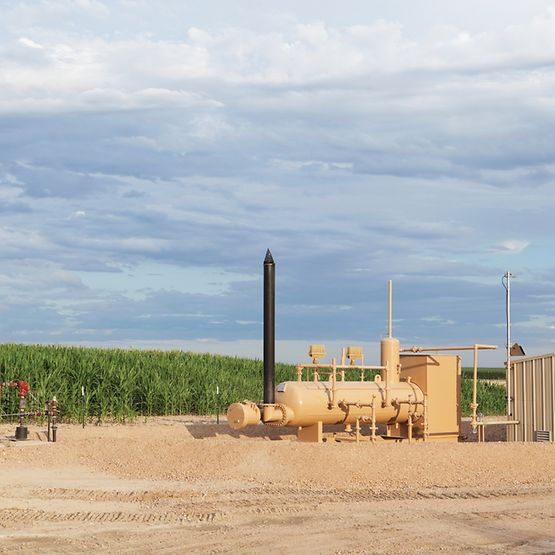
On this page
On March 4, 2024, a new satellite will orbit the Earth along with satellites like Starlink and GPS. The satellite has a unique mission - to detect and quantify methane emissions. The installation, called Methane Satellite, was created by the Environmental Defense Fund (EDF) to respond to global goals to reduce methane emissions and minimize global warming. Methane is a greenhouse gas 28 times more potent than carbon dioxide and has a huge impact on global warming, so monitoring and reducing methane emissions is critical to mitigating climate change.
Control valves play an important role in industrial processes, they control the flow and pressure of fluids. However, control valves can also be a significant source of unorganized emissions. Unorganized emissions are emissions of uncontrolled or untreated gases directly into the atmosphere. These emissions are not only harmful to the environment, they can also be harmful to human health. Therefore, reducing unorganized emissions from control valves is a common goal of engineers and environmentalists. With non-profit organizations like EDF and government agencies like the U.S. Environmental Protection Agency putting more pressure on industries, taking steps to reduce unorganized emissions from control valves is something that must be considered.
Fortunately, unorganized emissions can be significantly reduced through intelligent control valve design. Engineers are constantly improving the design and material selection of control valves to improve their sealing performance and durability, thereby reducing runaway emissions. This not only helps protect the environment, but also helps companies comply with increasingly stringent environmental regulations and reduce the economic losses caused by emissions.
When we think of the climate crisis, we usually think of carbon dioxide (CO₂) and methane. Methane is 28 times more potent as a greenhouse gas (GHG) than carbon dioxide and accounts for the majority of unorganized emissions from the oil, gas and chemical industries. According to statistics, 570 million tons of methane are released into the atmosphere every year, accounting for 20% of total greenhouse gas emissions. Of these, 20 percent of methane emissions come from the fossil fuel industry, while 60 percent of unorganized emissions come from valves, about 85.5 million tons per year. It can be seen that control valves are an important source of methane emissions, and improving their design and material selection plays an important role in reducing emissions.
According to the EPA, 80% of valve emissions escape through the packing that seals the stem. The packing is the material used in the valve for sealing, and it must be flexible enough to allow the valve to function properly without too much resistance, but tough enough to ensure a strong seal and minimize leakage. The valve standard for measuring and assessing runaway emissions is ISO 15484. By selecting the appropriate packing material and improving the packing design, the leakage emission of valve can be significantly reduced.
The choice of material will affect the amount of unorganized discharge of the valve. Depending on the application, most industrial control valves are packaged in the following materials: Polytetrafluoroethylene (PTFE) is resistant to most chemicals and temperatures, providing a durable, low-friction, and easy to maintain option; Graphite, a low-friction, durable material with excellent sealing and thermal conductivity; And specialty plastics that are so tough that they can maintain their performance characteristics under the most extreme conditions while remaining largely inert to chemical exposure. The selection of materials should reflect the medium to be transported, its volatility and corrosiveness. For example, when dealing with high temperature or corrosive media, it is particularly important to choose materials that are resistant to high temperature and corrosion.
In addition to material selection, packaging design also plays a key role in reducing unorganized emissions. Most valve packing configurations are V-shaped or O-rings that provide a tight seal around the stem. These designs effectively prevent media from escaping through the stem and reduce leakage. Another effective configuration is a live load filler, which, in addition to the filler, uses a spring to keep the stem under consistent pressure and maintain seal integrity. The live load filler automatically adjusts the pressure of the filler to compensate for seal failure due to wear or temperature changes, thus providing more stable sealing performance.
Metal bellows seal allows minimal leakage in any valve design. This precision is crucial when the medium of transport is dangerous or deadly, such as toxic chlorine or explosive hydrogen. The metal bellows seal provides the highest seal reliability by creating a continuous metal barrier around the stem that completely prevents media from escaping. Although the metal bellows seal provides a high degree of tightness, no other valve can completely eliminate runaway emissions. Therefore, in order to ensure the safety of people and the environment, all valves must meet specific standards.
In the context of increasingly stringent environmental regulations, choosing the right valve for your application becomes especially important. We adhere to high standards in valve design and material use without compromise. Our control valves are designed to last longer, perform better and minimize emissions in all operating conditions. In addition, our bellows seal can help you eliminate runaway emissions. No matter what industry you work in, our innovative solutions can help you meet stricter regulations and reduce your environmental impact. Contact our friendly sales engineers to learn more about our solutions.
